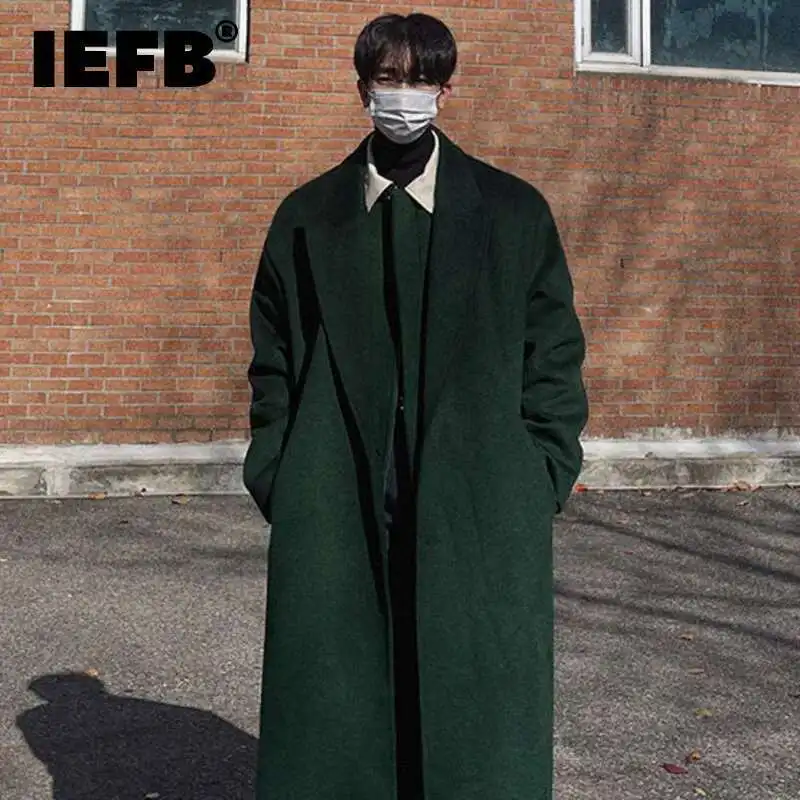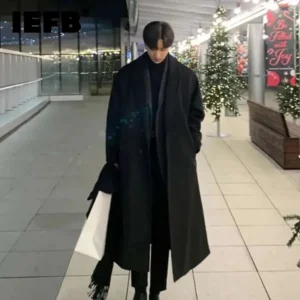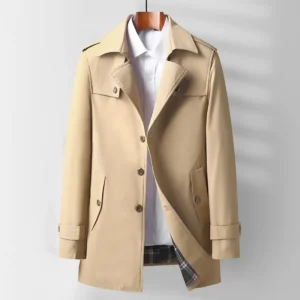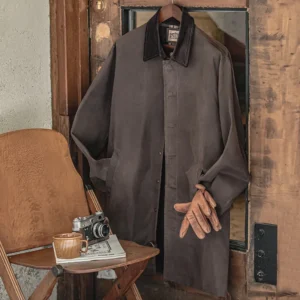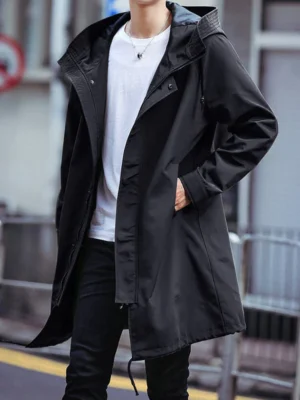Understanding the Allure of Long Overcoats
A long overcoat is more than just a winter garment—it’s a statement piece that extends past the knee, enveloping the wearer in an air of sophistication and authority. The enduring appeal of these classic pieces spans generations, having graced the shoulders of style icons from Humphrey Bogart to modern celebrities on red carpets worldwide.
The beauty of the long overcoat lies in its remarkable duality. While providing essential warmth during colder months, these garments simultaneously elevate any outfit they accompany. Few wardrobe pieces can match their transformative power—a well-fitted overcoat can instantly upgrade casual attire and add a distinguished finishing touch to formal wear.
There’s also an undeniable psychological impact when wearing a properly tailored overcoat. The structure creates a commanding silhouette that enhances posture and presence, while the protective embrace of quality fabric imparts confidence. This emotional response helps explain why understanding coat length contributes significantly to the overall effect of your outerwear.
Despite fashion’s ever-changing landscape, the long overcoat has maintained its position as a cornerstone of refined menswear. Its silhouette has evolved subtly through decades, yet its fundamental appeal remains unchanged—a testament to genuine timelessness in an industry often defined by fleeting trends.
Achieving the Perfect Fit: The Foundation of Overcoat Style
The difference between an ordinary overcoat and one that turns heads on the street begins with fit. Even the most luxurious fabric and impeccable craftsmanship cannot compensate for improper sizing. A well-fitted overcoat should feel comfortable while creating a clean, proportional silhouette.
When assessing fit, pay particular attention to these critical areas:
- Shoulders: The seam should rest slightly beyond your natural shoulder—approximately half an inch. This allows room for layering without creating a drooping effect.
- Sleeve length: Ideally, sleeves should end at your wrist bone, revealing 1/4 to 1/2 inch of your suit jacket or shirt sleeve when arms are relaxed.
- Overall length: The proper coat length typically falls anywhere from just above the knee to mid-calf, depending on your height and the specific style.
- Chest and waist: There should be enough room to comfortably button the coat over a suit or sweater without pulling or excess fabric bunching.
Different body types require specific considerations:
– Taller men (over 6‘2”) should seek longer coats to maintain proportion, while coat length can make you appear taller if you’re under 5‘8” by choosing styles that hit just above the knee.
– Athletic builds benefit from slightly tapered waists to highlight the V-shaped torso.
– Slimmer builds may prefer narrower lapels and less structured shoulders.
Common fit mistakes include sleeves hanging past the wrist, excessive shoulder padding creating a boxy silhouette, and choosing overly roomy coats that create a shapeless appearance rather than a clean line.
Remember that minor alterations can transform an almost-perfect coat into one that fits like it was custom made. Sleeve length, waist suppression, and even shoulder adjustments are possible in the hands of a skilled tailor.
Key Overcoat Styles and When to Wear Them
Understanding different overcoat styles helps you select the right coat for various occasions and personal preferences. Each style has distinctive characteristics that influence its formality and versatility.
Single-breasted Chesterfield
– Features: Single column of buttons, clean lines, often with a velvet collar
– Formality: Versatile; works with both suits and smart-casual attire
– Best for: Most body types; particularly flattering for slimmer builds
– Occasions: Office wear, evening events, weekend outings when dressed up
Double-breasted Overcoat
– Features: Two parallel rows of buttons, wider lapels, overlapping front closure
– Formality: More formal, commanding presence
– Best for: Taller men and athletic builds that can handle the additional fabric
– Occasions: Business meetings, formal events, cold winter days requiring extra warmth
Our double-breasted overcoat collection offers various interpretations of this classic style, while our guide to double-breasted styles explores the nuances between different variations.
Trench Coat
– Features: Belted waist, storm flaps, epaulets, typically in water-resistant fabric
– Formality: Business casual to formal, depending on styling
– Best for: All body types, as the belt creates a defined waist
– Occasions: Rainy weather, transitional seasons, business travel
Polo Coat
– Features: Double-breasted with a belt back, patch pockets, often in camel color
– Formality: Smart casual to business
– Best for: Taller men who can carry the length and fuller cut
– Occasions: Weekend brunches, casual office environments, outdoor sporting events
Ulster Coat
– Features: Heavier fabric, larger collar that can be turned up, belted or free-hanging
– Formality: Casual to smart casual
– Best for: Broader builds that complement the robust styling
– Occasions: Very cold weather, country weekends, casual winter outings
Each style carries its own heritage and communicates something different about the wearer. The clean simplicity of a Chesterfield projects efficiency and understated elegance, while the drama of a double-breasted coat suggests confidence and traditional taste.
Selecting the Right Fabric and Color
The fabric and color of your overcoat determine not only its appearance but also its functionality, durability, and versatility. Making informed choices in these areas ensures your investment delivers both style and performance.
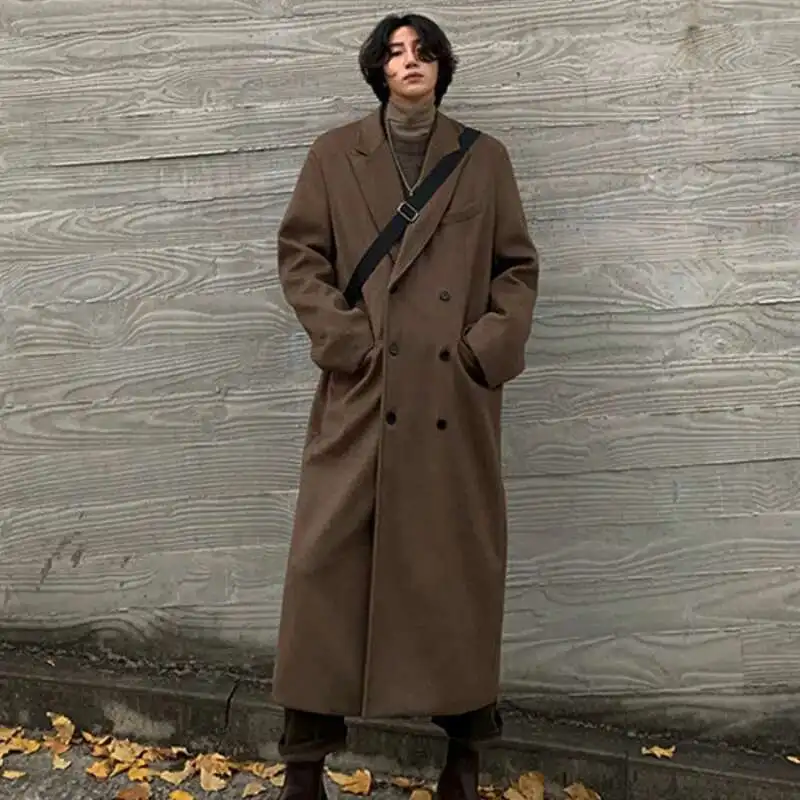
Key Fabric Options:
- Wool: The most common and versatile overcoat material. Our wool overcoat collection features various weights:
- Lightweight (14-16 oz): Ideal for milder winters or layering
- Midweight (18-20 oz): Standard for most urban environments
Heavyweight (22+ oz): Superior warmth for harsh winter climates
Cashmere and wool blends: Offers exceptional softness and insulation with less weight. Pure cashmere provides luxurious feel but requires more careful maintenance and comes at a premium price point.
Technical fabrics: Modern innovations combine natural fibers with synthetic materials for enhanced weather resistance and durability while maintaining a sophisticated appearance.
Textured options: Herringbone coats and tweed varieties add visual interest and often increased durability. These patterns also help disguise minor wrinkles or wear over time.
Color Selection Guide:
| Color | Versatility | Pairs Well With | Best For |
|---|---|---|---|
| Navy | Extremely high | Most colors, especially grays, browns, whites | Business, evening, casual wear |
| Charcoal | Very high | Black, blues, whites, burgundy | Professional settings, formal events |
| Camel | High | Navy, burgundy, forest green, denim | Making a style statement while remaining versatile |
| Black | High | Monochromatic outfits, bright accents | Evening wear, creative professional settings |
| Burgundy | Medium | Navy, gray, camel, cream | Standing out while maintaining sophistication |
| Forest Green | Medium | Neutrals, earthy tones | Casual to smart casual settings |
When selecting colors, consider:
– Your existing wardrobe colors to ensure compatibility
– Your skin tone (warmer complexions often suit camel and earth tones, while cooler complexions may favor blues and grays)
– The primary settings where you’ll wear the coat
Patterns add character but reduce versatility. A solid coat will coordinate with more outfits, while patterns like herringbone or windowpane offer visual interest at the cost of some versatility. For many men, beginning with a solid navy or charcoal coat provides the most styling options before expanding to patterned varieties.
Formal Styling: Elevating Business and Evening Wear
A long overcoat reaches its full potential when paired with formal attire, creating a complete expression of refined style. Mastering formal overcoat styling ensures you project confidence and sophistication in professional and special occasion settings.
For business environments, coordination between your suit and overcoat creates a harmonious appearance:
- Dark navy overcoats pair exceptionally well with charcoal, mid-blue, or light gray suits
- Charcoal overcoats complement navy, black, and patterned suits beautifully
- Camel overcoats create striking contrast with navy or charcoal suits for a bold executive look
When selecting accessories for business settings, consider these refined pairings:
- A cashmere scarf in a complementary or contrasting solid color adds warmth and sophistication
- Leather gloves matching your shoes maintain visual continuity
- A structured leather briefcase or portfolio completes the professional silhouette
Our dress coat selection offers several options specifically designed to enhance formal business attire while providing necessary weather protection.
For evening events and special occasions, the overcoat becomes the first and last impression you make:
- For black tie events, a black or midnight blue overcoat with satin or grosgrain lapels elevates the formal experience
- Consider subtle distinguishing details like velvet collars or covered buttons that enhance formality
- When attending cultural events like theater openings, introduce modest pattern through accessories rather than competing with the coat itself
Footwear plays a crucial role in formal overcoat styling. Oxford dress shoes create a seamless formal appearance, while dress boots with minimal detailing offer additional weather protection without compromising style. The formal overcoat tradition has evolved to incorporate these thoughtful details that distinguish truly polished dressing.
Professional styling tip: When wearing a formal overcoat, keep the top button fastened even when the coat is open to maintain a structured drape across the shoulders and chest. This small detail significantly enhances the overall impression of intentional elegance.
Smart-Casual and Weekend Styling
The versatility of a quality overcoat truly shines when incorporated into smart-casual ensembles. This approach creates an elevated everyday look that balances refinement with comfort—perfect for weekend activities and casual workplace environments.
Creating smart-casual looks with an overcoat involves thoughtful combinations:
Weekend Brunch Formula:
A camel overcoat paired with dark indigo selvedge denim, a cream cable-knit sweater, and brown Chelsea boots creates an effortlessly sophisticated appearance. Add a simple watch and minimal accessories to maintain the relaxed yet refined aesthetic.
Casual Friday Approach:
Layer a charcoal overcoat over a light blue Oxford shirt, navy chinos, and clean white leather sneakers. This combination respects office decorum while incorporating relaxed elements—the perfect balance for modern workplace culture.
Weekend Shopping Ensemble:
A navy overcoat transforms a simple white t-shirt, gray joggers, and minimal sneakers into a considered outfit. This high-low mix demonstrates style fluency and practical comfort.
The key to successful smart-casual styling is maintaining balance—the structured formality of the overcoat counterbalances more relaxed pieces. This creates visual interest through contrast rather than competition.
When incorporating casual elements like hoodies or t-shirts, quality becomes especially important. Choose well-made casual pieces with clean lines and minimal branding to ensure they complement rather than clash with your overcoat’s refinement.
Footwear transitions play a crucial role in smart-casual styling. While formal coat and suit combinations typically demand dress shoes, smart-casual looks offer more flexibility. Premium sneakers, desert boots, and loafers all pair beautifully with overcoats in casual contexts, creating an approachable yet elevated appearance.
Remember that texture creates depth in smart-casual outfits. Combining your smooth wool overcoat with textured knitwear, raw denim, or nubuck footwear creates sophisticated visual layers that elevate the overall effect beyond simple coordination.
Contemporary Styling: Breaking Traditional Rules
Today’s fashion landscape celebrates intentional rule-breaking and creative expression. Modern overcoat styling incorporates elements previously considered incompatible, creating fresh, relevant looks while maintaining the garment’s inherent elegance.
Contemporary styling approaches worth exploring:
- Streetwear fusion: Pairing a traditional overcoat with a graphic hoodie, distressed jeans, and premium sneakers creates compelling contrast between tailored and casual elements
- Color experimentation: Moving beyond traditional navy and charcoal by introducing burgundy, forest green, or even camel overcoats adds personality while remaining sophisticated
- Proportion play: Oversized overcoats worn with slim bottoms create dramatic silhouettes that reference runway trends while remaining wearable
- Fabric mixing: Combining traditionally formal coat fabrics with technical materials, like pairing a wool overcoat with performance pants and sneakers
Age considerations naturally influence contemporary styling choices:
- Younger men (20s-30s) can embrace bolder contrasts and streetwear elements
- Mid-career professionals (30s-40s) might incorporate subtle contemporary touches like unexpected colors or modern accessories
- Established professionals (50+) can refresh classic overcoat styling with contemporary fit adjustments and thoughtful texture combinations
Style icons demonstrating effective contemporary overcoat styling include actors, musicians, and athletes who maintain personal style signatures while incorporating modern elements. Their approaches often involve unexpected combinations that nonetheless feel intentional rather than random.
The key to successful contemporary styling lies in balancing tradition with innovation—pushing boundaries while respecting the overcoat’s inherent sophistication. When experimenting, maintain consistency in quality across all elements of your outfit to ensure coherence amid creative combinations.
Mastering Layering Techniques
Effective layering transforms your overcoat from mere outerwear into the centerpiece of a thoughtfully composed outfit. Beyond added warmth, proper layering creates visual depth and expands your wardrobe’s versatility across changing temperatures.
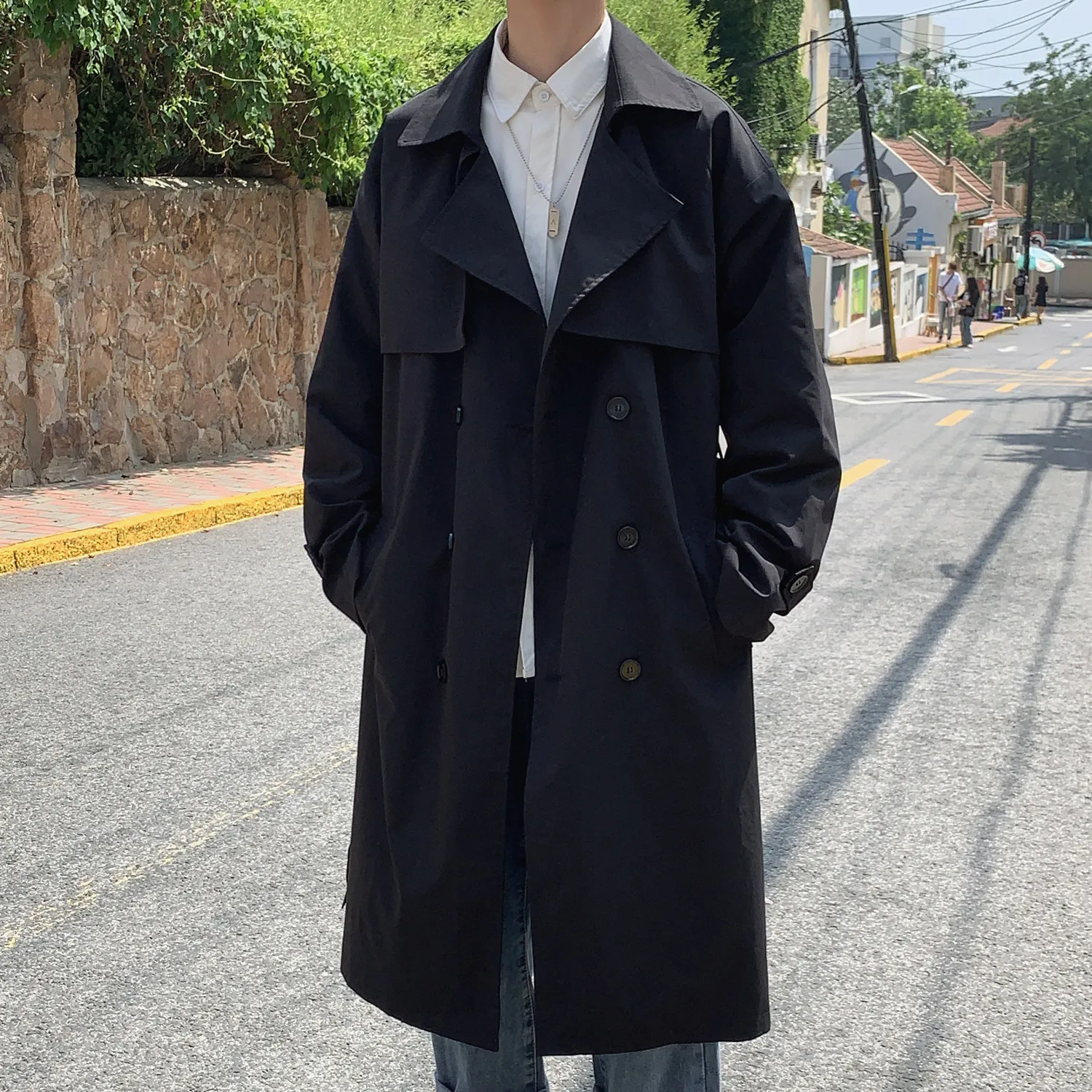
Essential Layering Principles:
- Graduated thickness: Begin with lightweight fabrics against the skin, progressing to heavier materials as you move outward
- Compatible lengths: Ensure each layer is visible in small, intentional increments—1/4” to 1/2” between shirt, jacket, and coat sleeves creates pleasing visual rhythm
- Movement consideration: Leave sufficient room for comfortable motion without restriction or bunching
- Material interaction: Choose fabrics that slide easily against each other to prevent binding or bunching
Winter Layering Strategy:
– Base: Fine merino or cotton undershirt
– Mid: Dress shirt or lightweight sweater
– Insulation: Suit jacket, blazer, or heavier knit
– Outer: Overcoat from our long overcoat collection
– Accessories: Scarf, gloves as needed
Transitional Season Approach:
– Base: Light cotton shirt
– Mid: Unstructured blazer or lightweight cardigan
– Outer: Overcoat (left unbuttoned when indoors)
Technical Layering Tips:
- Fabrics with natural stretch (wool with small elastane content) improve comfort when layering
- Slimmer inner layers with slightly roomier outer layers create the most flattering silhouette
- Monochromatic or complementary color schemes between layers create cohesive vertical lines
- Consider collar interactions—shirt, jacket, and overcoat collars should harmonize rather than compete
When layering beneath an overcoat, remember that each piece will compress slightly. Choose inner layers with enough structure to maintain their shape but sufficient flexibility to accommodate natural body movement. This balance ensures both comfort and aesthetic appeal throughout the day.
Essential Accessories to Complete Your Look
The right accessories enhance your overcoat’s impact while expressing personal style and providing additional functionality. These finishing touches transform a good outfit into a memorable one.
Scarf Selection and Styling:
– Materials: Cashmere for luxury and warmth, wool for durability, silk blends for transitional weather
– Draping methods: The simple overhand loop works with most overcoats, while the “once around” provides maximum warmth without bulk
– Color approach: Choose complementary colors for subtle sophistication or strategic contrast to create focal points
Glove Considerations:
– Leather gloves in brown or black create formal harmony when matched to shoes and belts
– Suede options add textural interest to monochromatic outfits
– Knit gloves offer casual functionality for weekend styling
– Ensure proper fit—gloves should extend just past the wrist with enough room for comfortable finger movement
Complementary Headwear:
– Fedoras and trilbys pair elegantly with formal overcoats
– Wool beanies create appealing contrast with structured coats in casual settings
– Consider scale—broader coat lapels support more substantial hat brims, while minimalist coats pair better with subtle headwear
Footwear Pairings:
– Formal overcoat styling: Oxford shoes, Derby shoes, or dress Chelsea boots
– Smart-casual combinations: Loafers, desert boots, or minimal leather sneakers
– Contemporary approaches: Premium athletic sneakers or technical boots
Bag Selection:
– Structured leather briefcases reinforce formal business styling
– Soft leather messenger bags bridge formal and casual contexts
– Canvas and leather totes offer weekend functionality while maintaining style integrity
When selecting accessories, consider both practical needs and visual balance. The overcoat’s substantial presence requires accessories with enough visual weight to maintain proportion—too-delicate pieces can appear insubstantial against the coat’s commanding silhouette.
Mens Black Overcoat, Mens Black Wool Coat, Mens Wool Overcoat
$339.18 Select options This product has multiple variants. The options may be chosen on the product pageMens Grey Overcoat, Mens Wool Blend Coat, Mens Wool Overcoat
$201.28 Select options This product has multiple variants. The options may be chosen on the product pageMens Herringbone Coat, Mens Long Overcoat, Mens Wool Overcoat
Price range: $197.16 through $203.69 Select options This product has multiple variants. The options may be chosen on the product pageMens Long Overcoat, Mens Topcoats
Price range: $189.40 through $196.88 Select options This product has multiple variants. The options may be chosen on the product pageMens Long Overcoat, Mens Tweed Coat
Price range: $397.49 through $409.96 Select options This product has multiple variants. The options may be chosen on the product pageMens Black Overcoat, Mens Long Overcoat
Price range: $100.12 through $173.24 Select options This product has multiple variants. The options may be chosen on the product page
Maintaining Your Investment: Care and Storage
Quality overcoats represent significant investments that, with proper care, can provide decades of service while maintaining their appearance. Establishing regular maintenance routines protects this investment and ensures your coat continues making the right impression.
Essential Care Protocols:
Wool overcoats: Brush after each wearing with a natural-bristle garment brush to remove surface debris. Spot clean minor marks immediately with a damp cloth and mild soap. Professionally dry clean only when truly necessary—typically once per season.
Cashmere blends: Handle with extra care to prevent pilling. Use a specialized cashmere comb to remove pills gently. Store with cedar products to deter moths.
Technical fabrics: Follow specific manufacturer guidelines. Many modern technical coats can be refreshed with specialized spray treatments to maintain water resistance.
Between-Wear Care:
- Allow 24 hours rest between wearings when possible
- Use wide, structured hangers that support shoulders without stretching
- Brush down before hanging to remove particles that can damage fibers over time
- Address minor stains immediately rather than allowing them to set
Seasonal Storage Essentials:
- Clean thoroughly before storing for extended periods
- Store in breathable garment bags—never in plastic
- Place cedar blocks or lavender sachets nearby to deter pests
- Store in cool, dry locations away from direct sunlight
- Add light padding to shoulders to maintain structure during storage
Professional Services Worth The Investment:
- Annual inspection and cleaning by quality dry cleaners familiar with premium garments
- Button reinforcement at the first sign of loosening
- Professional waterproofing treatments for coats frequently worn in inclement weather
Remember that prevention is always less expensive than repair. Regular light maintenance prevents the need for more intensive restoration later and preserves your overcoat’s appearance throughout its lifetime.
Building a Versatile Overcoat Collection
As your style evolves, thoughtfully expanding your overcoat collection allows you to address various occasions, weather conditions, and personal moods. Strategic acquisition creates maximum versatility with minimum redundancy.
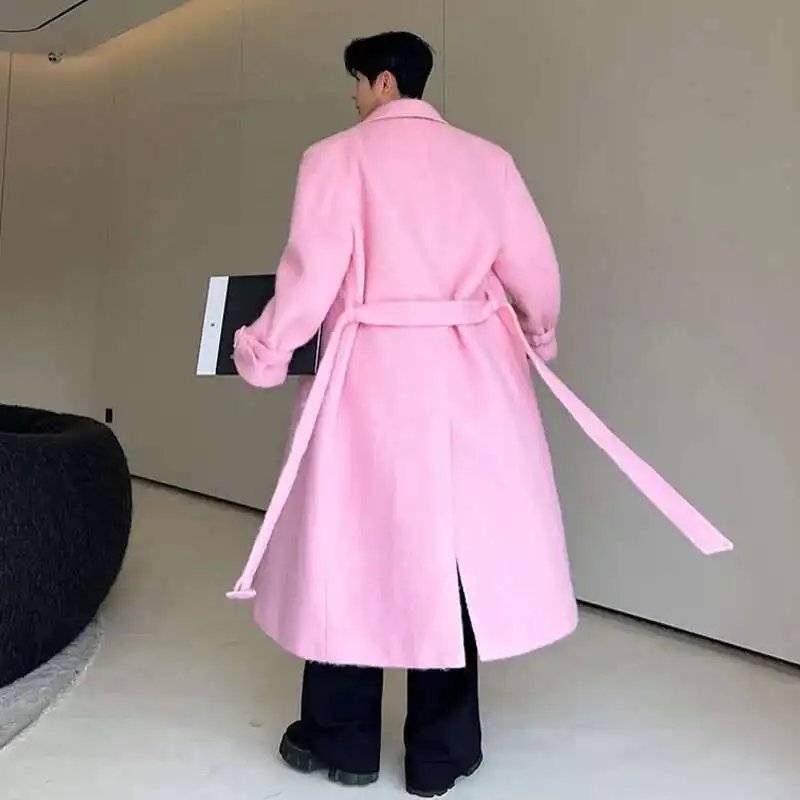
Foundation First Purchase:
Begin with a versatile navy or charcoal single-breasted wool overcoat in mid-weight fabric. This cornerstone piece works across business and casual settings and pairs with virtually anything in your wardrobe. Our black overcoat collection offers several excellent foundation options with timeless appeal.
Strategic Second Addition:
Once your foundation piece is established, consider a complementary style that serves different functions:
– If your first coat was dark, consider a camel or light gray option
– If you primarily purchased for business, add a more casual style with texture or pattern
– If climate is a significant factor, add a specialized weather-resistant option
Specialized Third Selection:
With fundamentals covered, your third overcoat can address specific needs or expressions:
– A statement piece in burgundy or with distinctive pattern
– An ultra-lightweight option for transitional seasons
– A technically advanced weather-proof style for extreme conditions
When building a collection, consider these factors:
– Climate requirements across seasons where you live and travel
– Professional and social obligations that demand different levels of formality
– Storage capacity available in your home
– Cost-per-wear value based on your lifestyle patterns
The most versatile collections typically include:
1. A formal dark option for business and evening
2. A smart-casual option with more personality
3. A specialized coat addressing specific local weather conditions
Quality always trumps quantity—fewer exceptional coats will serve you better than numerous mediocre ones. Each addition should fill a specific role in your wardrobe rather than duplicating functions you’ve already covered.
Overcoming Common Styling Challenges
Even with quality overcoats and styling knowledge, specific challenges can arise based on individual characteristics and circumstances. These practical solutions address common concerns to ensure your overcoat enhances rather than hinders your appearance.
Challenge: “Overcoats overwhelm my shorter stature.”
Solution: The best coat length for short men typically hits just above the knee rather than mid-calf. Look for coats with vertical details like narrow lapels and simplified pocket styles. Avoid belted styles that create horizontal lines. A skilled tailor can adjust not just length but also proportional details like pocket placement to create harmony with your build.
Challenge: “As a tall man, overcoats are often too short in the sleeves and body.”
Solution: Seek brands specializing in tall sizing or consider made-to-measure options. When shopping off-the-rack, prioritize sleeve length over body length, as body shortness can sometimes work as a contemporary style choice. The perfect coat length for every body type varies, but for tall men, mid-calf lengths typically create the most balanced proportion.
Challenge: “My overcoat creates a bulky appearance despite good fit.”
Solution: Examine the layering beneath—often bulk comes from too many or improperly chosen mid-layers. Choose thinner, warmer fabrics like merino wool and cashmere rather than bulky cotton. Consider having the coat’s shoulder padding slightly reduced if the structure is contributing to perceived bulk.
Challenge: “My formal overcoat feels too stuffy for casual settings.”
Solution: Transform formality through styling choices—pair with casual items like premium denim, soft knits, and minimal sneakers. Leaving the coat open with a casually wrapped scarf immediately reduces perceived formality while maintaining sophistication.
Challenge: “My overcoat restricts movement, especially when driving.”
Solution: Consider a coat with side or back vents to allow greater range of motion. For driving specifically, either remove the coat before entering the vehicle or look for styles with raglan sleeves and natural stretch wool that accommodate the forward arm position required for driving.
Challenge: “I struggle with appropriate overcoat length for my body type.”
Solution: The universal rule is that overcoat length should relate to your height while accommodating your proportions. Longer legs relative to torso typically support longer coats, while shorter legs look more balanced with shorter coat lengths. When in doubt, just-below-knee length works for most body types.
Have You Found Your Signature Overcoat Style?
As you apply the principles explored throughout this guide, remember that true style transcends mere rule-following. The most memorable dressers understand guidelines but adapt them to express individual character and preferences.
Developing your signature overcoat style involves identifying elements that resonate personally while complementing your physical characteristics and lifestyle. Perhaps you’re drawn to the dramatic flair of an Ulster collar or the clean lines of a minimalist single-breasted design. These preferences become part of your visual identity.
Consider these reflective questions when refining your overcoat approach:
- Which coat in your collection consistently receives compliments?
- What specific details (collar style, button placement, fabric texture) do you find yourself appreciating in coats?
- In what settings do you feel most confident, and what coat characteristics contribute to that feeling?
- Which historical or contemporary style figures inspire you, and what elements of their overcoat styling might you adapt?
Your relationship with overcoat styling will evolve over time. What begins as conscientious rule application gradually transforms into intuitive understanding. This evolution represents true style mastery—knowing both when to observe conventions and when creative deviation better serves your expression.
The perfect overcoat does more than insulate against cold; it projects confidence, competence, and character. Whether you’re stepping into an important meeting, enjoying a weekend cultural event, or simply navigating your daily routine, a thoughtfully chosen and properly styled overcoat serves as both armor and announcement of your presence.
Wear yours with the quiet confidence that comes from knowing you’ve mastered one of menswear’s most enduring and impactful garments.

